Perhaps it really was a world premiere when the dragon (English: Dragon) recently competed against the sheep (French: Mouton) at a private tasting of wines from China and Bordeaux. "Dragon" stands for China's wine production, because "Noble Dragon" from Shandong is one of the best-known Chinese wines and "Dragon Seal" in Beijing is one of the pioneers among China's wineries. Mouton, the sheep, on the other hand, represents the multi-company of the Rothschilds, which has its headquarters in Bordeaux.
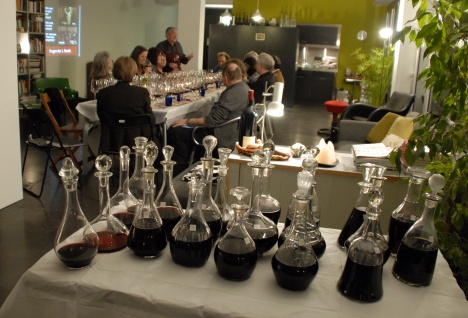 |
| World premiere of a wine tasting: China versus Bordeaux |
Those who know something about China's wines quickly associate them with mass production in the style of "Mouton Cadet" from the Rothschilds, as certain basic conditions are amazingly similar: more than 300 suppliers from a large, defined wine region, the most modern technology in processing, huge quantities as output, strictly controlled, always equal quality, worldwide marketing... China already wants to and can keep up with this. Dragon Seal" alone - one of about 10 large wineries - produces over 4 million bottles per year. Another company, "Changyu" in Yantai, the oldest winery in China, today has a vineyard area of 4600 hectares, and the Hua Xia Winery with the probably most popular Chinese wine "Great Wall" has increased its annual production from 8000 to 46000 tons in eight years. But what about the quality?
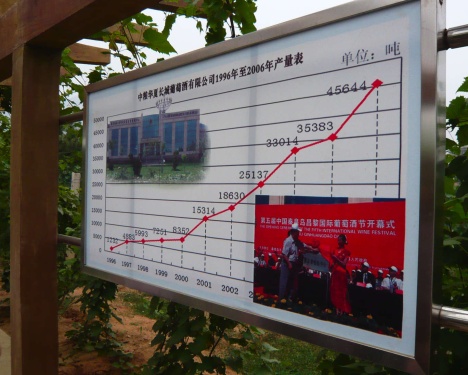 |
| Production development at Great Wall |
This is exactly what we wanted to know. Can "Mouton Cadet" be compared with the Chinese wines (from the same price range (around 10 Euros)? Can the Dragons and Great Wall keep up? They can! Blind tasting: Mouton Cadet, Great Wall (Huaxia Selection) and Golden Dragon from the Qinhuangdao area. Spontaneous ranking: the "Golden Dragon" (wine producer not declared) came out on top, ahead of "Great Wall" and - behind - Mouton Cadet. The differentiation of the individual wines was not easy. All three were in the range of clean, fruity, full-bodied, fresh, crisp and what you write when you have to characterise a rather average wine.
Oops, that was already a shot across the bow. The dragons can hold their own, they are even superior to the sheep. It must be the vintage of Mouton Cadet (2007) or the storage in the Superdiscount. We thought!
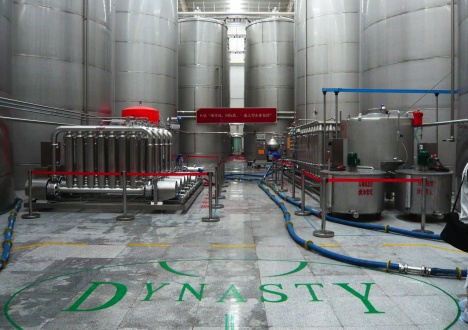 |
| Production plant: Wine tanks on Dynasty (scaled down) |
Therefore, immediately to the next round. This time from the much higher segment: Dynasty from Tianjin and Huadong-Parry (Founder's Reserve) from Qingdao compared with Pavie (St-Emilion) and Grand-Puy-Lacoste (Pauillac). We took the two Chinese wines in our hand luggage from our wine trip through China, the two Bordeaux came from my cellar. Pavie could be compared mainly with Dynasty, both are merlot-driven. The Dynasty wine corresponds to the Chinese luxury segment - price range around 200 euros - and is intended for the Chinese market (for prestigious occasions). We tasted the wine (as guests of honour) at the winery, but could not buy it there. However, we were given a bottle without a label. Vintage not quite clear: probably 2000.
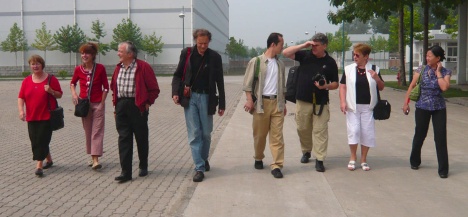 |
| Swiss wine expedition in China. Here at Vineyard Dynasty in Quingdao. |
And again it beat the competition. Although the Chinese wine was still clearly too young (the Pavie, on the other hand, was a 1994), it showed balance, power, fruit and presence that amazed us. Only one Bordeaux - the excellent 2000 Lacoste - could keep up in this round. It was closely followed by the Dynasty, then the Huadong-Parry, but already with some distance. The Pavie, on the other hand, clearly fell behind. Now it was getting a bit scary for us. Such strong Chinese! Not comparable to what we get here in Europe as "Chinese wines" from time to time as exotics in the glass. This top segment in Chinese wine production is designed to compete with the expensive wines from the Bordelais. We were told again and again in China. "We want to compete with the best Bordeaux in the top segment soon! In addition, we produce the best possible mass wines, on the one hand to boost wine consumption in China, and on the other hand for export. The potential for Chinese wine is there."
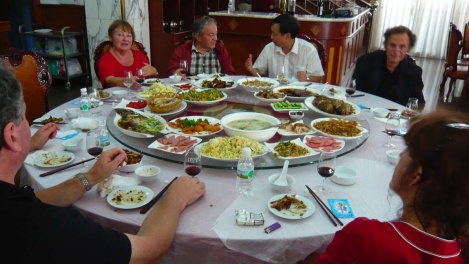 |
| Invitation to Vineyard Dynasty. The meal will be accompanied by the winery's top wine. |
The other three rounds (with four wines each) were similar. Although the Bordeaux wines (including Cos d'Estournel 2002, Lafite Rothschild 1979, Sociando-Mallet 2003, Lagrange, 1961!) usually came out on top, the Chinese were always able to keep up. The biggest difficulty in the comparison was the age of the wines. China does have a tradition in viticulture, but this was interrupted for many years and decades and only resumed at the end of the 1980s. The oldest two wines from China were the vintages 1992 and 1995, from the Changyu Castel winery (Yantai). We tasted these blind together with Lafite and Lagrange. A somewhat unfair comparison, admittedly. The result was all the more astonishing. The "oldest" Chinese wines were still youthful, fresh and as present on the palate as if they had been bottled only five years ago.
 |
| State-of-the-art production and bottling facilities on Great Wall |
We can only speculate about the real ageing potential. But one thing is certain for me after this blind tasting: something is rolling towards us from China! It will take a few years or decades to catch up with the "old wine world". The sheep does not have to fear the dragon yet, but at least it has to take him first. Because the realm of the dragon is bigger, far more goal-oriented, moreover ambitious and equipped with the best know-how and the most modern technology from the "old wine world". I am now completely convinced of this - after our journey through wine China and our tasting "world premiere".